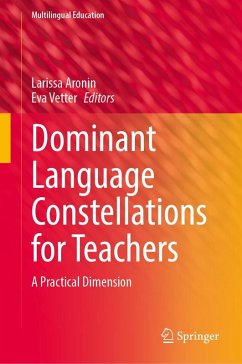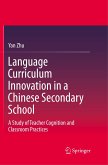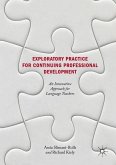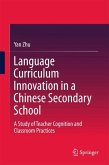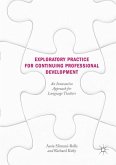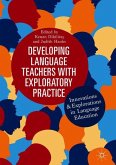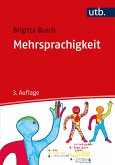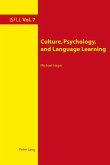Dominant Language Constellations for Teachers
A Practical Dimension
Herausgegeben:Aronin, Larissa; Vetter, Eva
Dominant Language Constellations for Teachers
A Practical Dimension
Herausgegeben:Aronin, Larissa; Vetter, Eva
- Gebundenes Buch
- Merkliste
- Auf die Merkliste
- Bewerten Bewerten
- Teilen
- Produkt teilen
- Produkterinnerung
- Produkterinnerung
This book focuses on practical use of the Dominant Language Constellations (DLC) approach, not only in formal settings, but also in social and family domains. It addresses the daily needs of all those who deal with multilingual reality. The key unique feature of the volume is its focus on giving practical advice, recommendations, and suggestions that can help individuals deal with real-life multilingual situations. It covers multiple social and geographical contexts, bringing insights into working directly with family members, children and adults, and educational stakeholders. While based on…mehr
Andere Kunden interessierten sich auch für
![Language Curriculum Innovation in a Chinese Secondary School Language Curriculum Innovation in a Chinese Secondary School]() Yan ZhuLanguage Curriculum Innovation in a Chinese Secondary School76,99 €
Yan ZhuLanguage Curriculum Innovation in a Chinese Secondary School76,99 €![Exploratory Practice for Continuing Professional Development Exploratory Practice for Continuing Professional Development]() Assia Slimani-RollsExploratory Practice for Continuing Professional Development65,99 €
Assia Slimani-RollsExploratory Practice for Continuing Professional Development65,99 €![Language Curriculum Innovation in a Chinese Secondary School Language Curriculum Innovation in a Chinese Secondary School]() Yan ZhuLanguage Curriculum Innovation in a Chinese Secondary School76,99 €
Yan ZhuLanguage Curriculum Innovation in a Chinese Secondary School76,99 €![Exploratory Practice for Continuing Professional Development Exploratory Practice for Continuing Professional Development]() Assia Slimani-RollsExploratory Practice for Continuing Professional Development65,99 €
Assia Slimani-RollsExploratory Practice for Continuing Professional Development65,99 €![Developing Language Teachers with Exploratory Practice Developing Language Teachers with Exploratory Practice]() Developing Language Teachers with Exploratory Practice76,99 €
Developing Language Teachers with Exploratory Practice76,99 €![Mehrsprachigkeit Mehrsprachigkeit]() Brigitta BuschMehrsprachigkeit22,90 €
Brigitta BuschMehrsprachigkeit22,90 €![Culture, Psychology, and Language Learning Culture, Psychology, and Language Learning]() Michael HagerCulture, Psychology, and Language Learning78,85 €
Michael HagerCulture, Psychology, and Language Learning78,85 €-
-
-
This book focuses on practical use of the Dominant Language Constellations (DLC) approach, not only in formal settings, but also in social and family domains. It addresses the daily needs of all those who deal with multilingual reality. The key unique feature of the volume is its focus on giving practical advice, recommendations, and suggestions that can help individuals deal with real-life multilingual situations. It covers multiple social and geographical contexts, bringing insights into working directly with family members, children and adults, and educational stakeholders. While based on DLC theory and empirical studies, this volume appeals directly to practitioners, both in-service and future teachers, as well as teacher educators, parents and social workers in multilingual settings.
Produktdetails
- Produktdetails
- Multilingual Education 50
- Verlag: Springer / Springer Nature Switzerland / Springer, Berlin
- Artikelnr. des Verlages: 89295581, 978-3-032-03303-1
- Seitenzahl: 320
- Erscheinungstermin: 21. Januar 2026
- Englisch
- Abmessung: 235mm x 155mm
- ISBN-13: 9783032033031
- ISBN-10: 3032033039
- Artikelnr.: 74926597
- Herstellerkennzeichnung
- Springer-Verlag GmbH
- Tiergartenstr. 17
- 69121 Heidelberg
- ProductSafety@springernature.com
- Multilingual Education 50
- Verlag: Springer / Springer Nature Switzerland / Springer, Berlin
- Artikelnr. des Verlages: 89295581, 978-3-032-03303-1
- Seitenzahl: 320
- Erscheinungstermin: 21. Januar 2026
- Englisch
- Abmessung: 235mm x 155mm
- ISBN-13: 9783032033031
- ISBN-10: 3032033039
- Artikelnr.: 74926597
- Herstellerkennzeichnung
- Springer-Verlag GmbH
- Tiergartenstr. 17
- 69121 Heidelberg
- ProductSafety@springernature.com
Larissa Aronin is a University Professor at the VIZJA University in Warsaw, Poland. She is a Distinguished scholar in multilingualism (IAM, Groningen 2024). She has served two terms as a Board Member of the International Association of Multilingualism and is as an Editorial Board member of a number of peer-reviewed journals. She has published multiple articles, encyclopedia entries and books on multilingualism and applied linguistics. Among the most recent ones are three volumes on DLC in 2020, 2021 and 2023 (Springer) and the textbook on Multilingualism An Advanced Guide to Multilingualism 2022, published by Edinburgh University Press. Eva Vetter is an applied linguist and has been a professor of language teaching and learning research at the University of Vienna since 2011. She was previously a teacher of French and geography. Her research interests focus on the relationship between language and power, particularly in the field of education. How are inequalities produced linguistically and equal opportunities strengthened? She researches topics such as language policy, heteroglossic language use, linguistic minorities or political and public discourses of inclusion and exclusion. She sees her academic work as a contribution to peaceful coexistence in a sustainable society.
Chapter 1. Foreword: A Concept and a Profession: The Relevance and Power of the DLC for Teachers.- Chapter 2. Introduction: A practical dimension of the Dominant Language Constellation approach in education.- Part I. Organizational issues of DLC practices.- Chapter 3. Plurilingual Curricula and Functional Multilingualism: Opening up new research spaces with the Supra-individual Dominant Languages Constellations model (SuDoLanCos).- Chapter 4. The dominant language constellation as a concept with which to increase student teachers awareness of institutional language diversity A case study from Finland.- Chapter 5. DLCs as a Pedagogical Tool for Promoting Multilingual Identities Among Undergraduate Students in U.S. Higher Education Institutions.- Part II. DLC practices in a classroom.- Chapter 6. 'Vizibilising' multilingualism in school education through students' and teachers' DLC representations and artefacts.- Chapter 7. A DLC classroom approach to fostering multilingual identities in adolescent learners with different linguistic profiles.- Chapter 8. Raising awareness of dialectal diversity through DLCs of YLS in Croatian primary schools.- Part III. DLC practices in English teacher education.- Chapter 9. Transforming English Language Teacher Education Through Arts-Based Approaches to DLCs.- Chapter 10. DLC artefacts as plurilingual practice in pre-service English teacher education: a comparative study in Portugal and Norway.- Chapter 11. Dominant Language Constellation as a Pedagogical Practice in Pre-Service Teacher Education.- Chapter 12. Language Teachers thinging through Dominant Language Constellations: The Materialization of Beliefs about Languages and Multilingualism.- Chapter 13. Navigating Multilingual Classrooms: Elevating EFL Pedagogy Through DLC Reflective Practice.- Part IV. DLC practices in multilingual families and school activities.- Chapter 14. The dynamic DLC of mobile multilingual families.- Chapter 15. Dominant Language Constellations, Visual and Artefactual Representations of Multilingualism by EFL Students in Cyprus.
Chapter 1. Foreword: A Concept and a Profession: The Relevance and Power of the DLC for Teachers.- Chapter 2. Introduction: A practical dimension of the Dominant Language Constellation approach in education.- Part I. Organizational issues of DLC practices.- Chapter 3. Plurilingual Curricula and Functional Multilingualism: Opening up new research spaces with the Supra-individual Dominant Languages Constellations model (SuDoLanCos).- Chapter 4. The dominant language constellation as a concept with which to increase student teachers awareness of institutional language diversity A case study from Finland.- Chapter 5. DLCs as a Pedagogical Tool for Promoting Multilingual Identities Among Undergraduate Students in U.S. Higher Education Institutions.- Part II. DLC practices in a classroom.- Chapter 6. 'Vizibilising' multilingualism in school education through students' and teachers' DLC representations and artefacts.- Chapter 7. A DLC classroom approach to fostering multilingual identities in adolescent learners with different linguistic profiles.- Chapter 8. Raising awareness of dialectal diversity through DLCs of YLS in Croatian primary schools.- Part III. DLC practices in English teacher education.- Chapter 9. Transforming English Language Teacher Education Through Arts-Based Approaches to DLCs.- Chapter 10. DLC artefacts as plurilingual practice in pre-service English teacher education: a comparative study in Portugal and Norway.- Chapter 11. Dominant Language Constellation as a Pedagogical Practice in Pre-Service Teacher Education.- Chapter 12. Language Teachers thinging through Dominant Language Constellations: The Materialization of Beliefs about Languages and Multilingualism.- Chapter 13. Navigating Multilingual Classrooms: Elevating EFL Pedagogy Through DLC Reflective Practice.- Part IV. DLC practices in multilingual families and school activities.- Chapter 14. The dynamic DLC of mobile multilingual families.- Chapter 15. Dominant Language Constellations, Visual and Artefactual Representations of Multilingualism by EFL Students in Cyprus.

